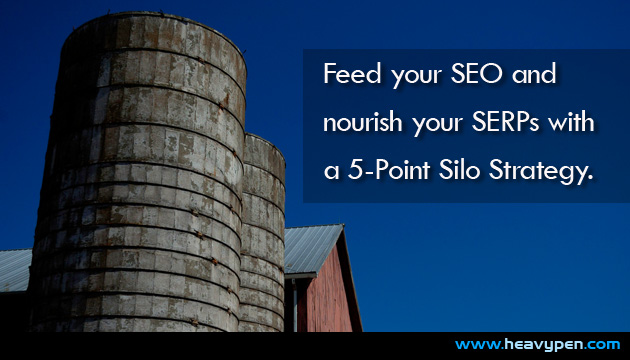
5-Point Content Silo Plan that will help you Boost Your Search Results Strategy
Build a Content Silo Strategy that stacks up SERP-focused content rich with relevant and tightly targeted search terminology—and triggers the rabbit hole diggers.
Grain silos are fascinating inventions. Farmers harvest grain then drop it all into tall cylinders as a means of storage. When it’s time distribute the seed, all you have to do is open a chute near the bottom. Gravity does all the work for you. Ingenious.
Content silos are just as fascinating for two reasons. One is the visual: a stack of content that’s specifically designed to trigger target audiences to dig deep into reasons they should be doing business with you. The other is behavioral: a stack of content designed to trigger the “rabbit hole diggers” in your target audience. Yes. Deep rabbit holes with lots of product/service details, features, comparisons, use data, scenarios, history… everything (oh the thinks you can think, and more). Read up on content writing strategies for niche markets where we explore how specific content encourages inquiry. Content silos are the mechanism to make that happen.
What is a Content Silo?
Search engines have to satisfy each search request with the most relevant content possible. It’s also in their design to be efficient and specific as possible. That’s why spiders (the little robots that index web content) categorize word usage, theme and relevancy of every page they come across. So, what does that mean? You want to nourish just the right search engine results page (SERP) to draw in the eyeballs and keep them on you for as long as possible.
Pick a topic and create individual pages that are chock full of original content that relates to THAT topic. Check to make sure that the keyword focus is the same for each article in the silo. Replicate and differentiate for a new silo equipped with more narratives, how-to’s, hacks, workarounds, histories, personal experiences, and other insight that meets various target market needs. Think of your content silos as a full stack of knowledge. Success (for your website) comes in the form of a higher page authority ranking, greater search visibility, and higher ranking (placement) for your target SERP (see below). Do this repeatedly and your website will earn the distinction as an authority for the promoted keyword/phrase.
The strategy: make sure you have plenty of content silos that can attract search engine spiders (again, niche duplication, differentiation). Imagine what happens when visitors find a stack of easy-to-consume and informative articles, then leaves! That’s no good. We want them to ‘dwell’ on our content longer. The longer the better. Silos give them plenty of content to chunk down as they research their purchase. All you have to do is make sure that the content is easy to digest, easy to understand, and easy to remember. The best part is that, thanks to your silo, your Call-to-Action (CTA) will take care of itself. Lay off the sales pitch—focus on the conversation so that your readers will look for the “buy” tab.
The best part of silo strategy is that it only sounds complicated. All it takes is a little focus: content creation wise, that is.
A 5-Point Silo Strategy for your Content
- Develop content that focuses on your target SERP. SERPs are targeted ‘search engine results pages’. These are pages you want to target based on keywords and/or phrases your audience may use to find you. Let’s say you want to push into the top 10 for “custom treehouse.” That’s where your plan for content creation and site structure should begin. The goal is to build your page authority based on the targeted keywords. You may have other keywords you want to include, but whittle your priority down to one search engine results page—in this case, building the perfect “custom treehouse.” Be as specific as you can. Believe in your target audience and develop content accordingly.
- Focus on relevancy, not just keywords. Keyboard in hand, dive right in and write articles about how you built custom treehouses. Think of features you think make treehouses really cool. Write about hacks, concepts, new ideas, and (yes) even shortcuts for do-it-yourselfers. Minimize the sales pitch and remember that How-to’s always rank better than what for’s. Make sure that your target keyword appears in one of the three: the headline (H1), sub-head (H2), and the first sentence. Repeat the keyword about once every 70 words or so. But don’t go crazy with the actual word count. And be mindful that too many instances of the same pattern raises the risk of getting flagged as “spammy.” Note also that Google has an algorithm that detects articles written for SEO ranking; they know all the tricks. So, beware and focus on context and relevance.
- Optimize article length. Shoot for 600 words per each post or page; smaller than that, and you’ll have a harder time reaching higher search visibility. Low content count (less than 300 per page) may put you at risk for the “thin content” penalty. There’s an ongoing debate about word-count, but assume there’s no maximum. Some tests have shown that longer articles rank better than shorter articles. However, I have found that shorter articles with lots of graphics or photos seem to rank very well compared to long articles with fewer graphics/photos. Makes sense, no?
- Target page and blog post count. My recommendation: write at least ten articles (pages and/or blog posts) for each “silo” – the more, the better. Yeah, it’s a lot of writing for some folks. That’s why you might hire help if you feel that writing is not a core skill. Silo strategy has an equation: quality plus quantity equals authority. I’ll share a little secret about writing. When you write about a topic you really know, try to write the way you’d talk to a friend who wants to learn about what you do. Keep it simple; keep it plain; and keep it focused.
- Go the extra mile. Add a video that focuses on one aspect you explain in the article. Think short video—30 seconds or more about one aspect of “custom treehouses” (for instance). Upload the video to YouTube, optimize the title, keyword tags, and embed the video into the article itself. And if you need some lengthening for the text article, add portions of the transcript from the video.
Finally, make sure that all articles have a nice introduction that’s blended with the main content. Resist the urge to copy the intros from other articles. Google demotes all articles that have too much duplicated text. Use different headlines and don‘t “boilerplate” the end of your articles (don’t repeat the same ending, over and over). If you have a Call-To-Action, keep your branded taglines, but reword the offer/incentive with each instance.
Measuring the “Silo Effect”: how deep does that rabbit hole go?
Need a metric for the silo? Watch your “bounce rate” (Google Analytics): the number of times that visitors hit a site and leave. A well-executed silo strategy will drive your bounce rate lower (about 10-15 points below your average) because more visitors will dig deeper into your content. It’s not the most important measurement. You’ll also want to pay attention to Google’s “average time on page” (AToP); the bigger the number, the better. Used together, your cumulative analytics will show if your silo strategy is on target and having a good effect on your audience. If the bounce rate creeps higher and AToP slips below 2-3 minutes, consider rewrites, or add more content.
Got more to say? Make more silos.
That leads me to the final consideration. As I mentioned earlier, one silo should comprise at least 10 separate articles; and if possible, each will have its own short video, meme, and/or infographic. Moreover, the average marketer can serve at least two target audiences, and each of those audiences can have multiple subdivisions. Therefore… add more silos as needed! Yep. You can have more than just one. Let’s say the parallel of your business of building “custom treehouses” is “treehouse supplies.” What if you want to sell “do-it-yourself treehouse plans” or “step-by-step guides”? Get the idea? Some content managers may recommend that you start with one silo, and they’d be right. But there’s no reason on God’s green Earth that you should keep it that way.
About: Ray Wyman, Jr is a content creator, communications professional, and author with more than 30 years of experience. Visit LinkedIN or Raywyman.com for more information.



I’ve been writing a lot of blog posts lately and kind of losing my way. This article really helped me refocus what I’m doing and how I should approach things.